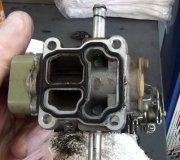Here are the diagnostics for P0137
DTC P0137: REAR HEATED OXYGEN SENSOR (HO2S) LOW VOLTAGE
Diagnostic Aids
If more than 155 seconds have passed since front HO2S heating period started, code will set if rear HO2S voltage is less than -150 millivolts. Monitor runs continuously. Two trip fault.
Check for:
"� Short to ground in Blue wire between rear HO2S and ECM.
"� Rear HO2S malfunction.
Procedure
NOTE:
Record all freeze frame data before disconnecting any connectors or clearing codes.
1. Turn ignition off. Disconnect rear HO2S 4-pin connector and ECM 88-pin connector. Check for continuity between ground and ECM connector terminal No. 39 (Blue wire). See Fig. 5 . If continuity exists, repair short to ground in Blue wire between rear HO2S and ECM. If continuity does not exist, go to next step.
2. Connect rear HO2S connector and ECM connector. Start engine and let idle. When engine reaches normal operating temperature, backprobe and monitor voltage between rear HO2S connector terminal No. 4 (Blue wire) and ground. Increase engine speed to 2000-2500 RPM for 5-10 seconds, then release throttle. Repeat several times while monitoring rear HO2S voltage. Rear HO2S voltage should rise during sustained high RPM and drop significantly when throttle is snapped shut. If rear HO2S voltage does not change as specified, replace rear HO2S. If rear HO2S voltage changes as specified, check rear HO2S connector and ECM connector for loose, damaged or corroded terminals. If problem exists, repair appropriate connector.

SHIFT & TCC SOLENOIDS
1. Ensure ignition is off. Disconnect TCM harness connector. Measure resistance between ground and solenoid terminal # 22 at TCM harness connector. Resistance should be 11-15 ohms at 68 °F (20 °C).
2. If resistance is not as specified, disconnect transmission solenoid connector and check harness between TCM and transmission connector for short or open. If harness is okay, go to next step.

3. Disconnect 3-pin transmission solenoid connector from vehicle harness. Note that solenoids ground through transmission case. Check resistance between 3-pin connector terminals and ground. Replace solenoids as necessary.
4. If resistance is okay, ensure transmission case is grounded and intermittently connect battery voltage to terminals of 3-pin connector. An audible click should be heard from specified solenoid when voltage is applied. If click is not heard, replace solenoid.
Tuesday, September 28th, 2010 AT 11:59 AM




